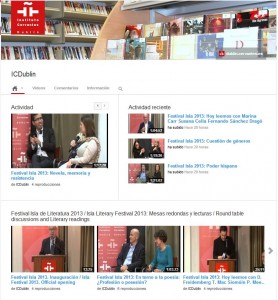Blog del Instituto Cervantes de Dublín
Torre Martello
Día de los muertos, Halloween / Day of the Dead, Halloween
Se acerca el día 1 de noviembre, una fecha llena de misterio, una noche en la que se dice que los muertos despiertan y vuelven a pasear sobre la tierra. En esta fecha tienen lugar diferentes celebraciones por todo el mundo, como Halloween en Irlanda o el Día de Muertos, en México.
Según la tradición celta, que se celebraba originalmente en Irlanda, Reino Unido y Francia, pero que se ha extendido por toda Europa y Norteamérica, ésta es la noche de Halloween, una noche en la que las criaturas del Más Allá vagan libremente de nuevo, sembrando el terror y causando problemas a los vivos, que han de disfrazarse para mantener alejados a los espíritus. Esta costumbre se mantiene hasta nuestros días, aunque los espíritus modernos parece que no dan tanto miedo como sus antepasados…
Sin embargo, en la tradición mexicana, los muertos no regresan a la tierra a dañar y asustar a los vivos, sino a visitar a sus seres queridos. En México, durante el Día de Muertos se adora a los difuntos desde el respeto y el cariño, y no desde el miedo.
Por este motivo, el Día de Muertos en una gran fiesta, un banquete al que tanto vivos como muertos están invitados. Las familias preparan el camino de retorno de las almas, mediante altares en las casas y adornando el camino desde el cementerio con flores, velas y ofrendas para agradar a los difuntos, ya que si están satisfechos traerán consigo la prosperidad.
Ésta celebración, que combina los ritos prehispánicos con la tradición católica, fue declarada Patrimonio Inmaterial de la Humanidad por la Unesco en 2003, apoyando la tradición de los pueblos indígenas de México.
No cabe duda de que son celebraciones muy diferentes, pero que comparten algo en común: la creencia de que el día 1 de noviembre los muertos vuelven a la tierra…nosotros, por si acaso, el 31 cerramos la biblioteca.
The 1st of November is coming, a date full of mystery, a night when the dead wake up and walk on Earth again. According to the Celtic tradition, originally celebrated in UK, Ireland and France, but now spread all over Europe and North America, this is the night of Halloween, a night when the creatures from the afterlife wander freely again, scaring and making trouble to the living, who must dress up to keep the spirits away. This tradition prevails today, although modern spirits seem not to scare as much as their ancestors did.
However, in the Mexican tradition, the dead don’t come back to earth to hurt and scare the living, but to visit their loved ones. In México, during the “Day of Death“, the deceased are adored not with fear, but with love and respect.
For this reason, el “Día de Muertos” is a big party, a banquet where both the dead and the living are invited to. Families prepare the return trip of the souls with altars in the houses and flowers, candles and offers along the way from the cemetery in order to make their deceased happy; if they are satisfied, they will bring prosperity.
The celebration, which combines prehispanic rituals with the catholic tradition, was declared Intangible Cultural Heritage by UNESCO in 2003, supporting the traditions of indigenous communities from México.
No doubt, these celebrations are very different, but they have something in common: the belief that in November 1st the dead come back to life… Just in case, we’re going to close the library in October 31st…
Bibliografía / Bibliography:
Nombran Patrimonio de la Humanidad el Día de los Muertos
Día de Muertos: Obra Maestra del Patrimonio Mundial de la Humanidad
Las fiestas indígenas dedicadas a los muertos




